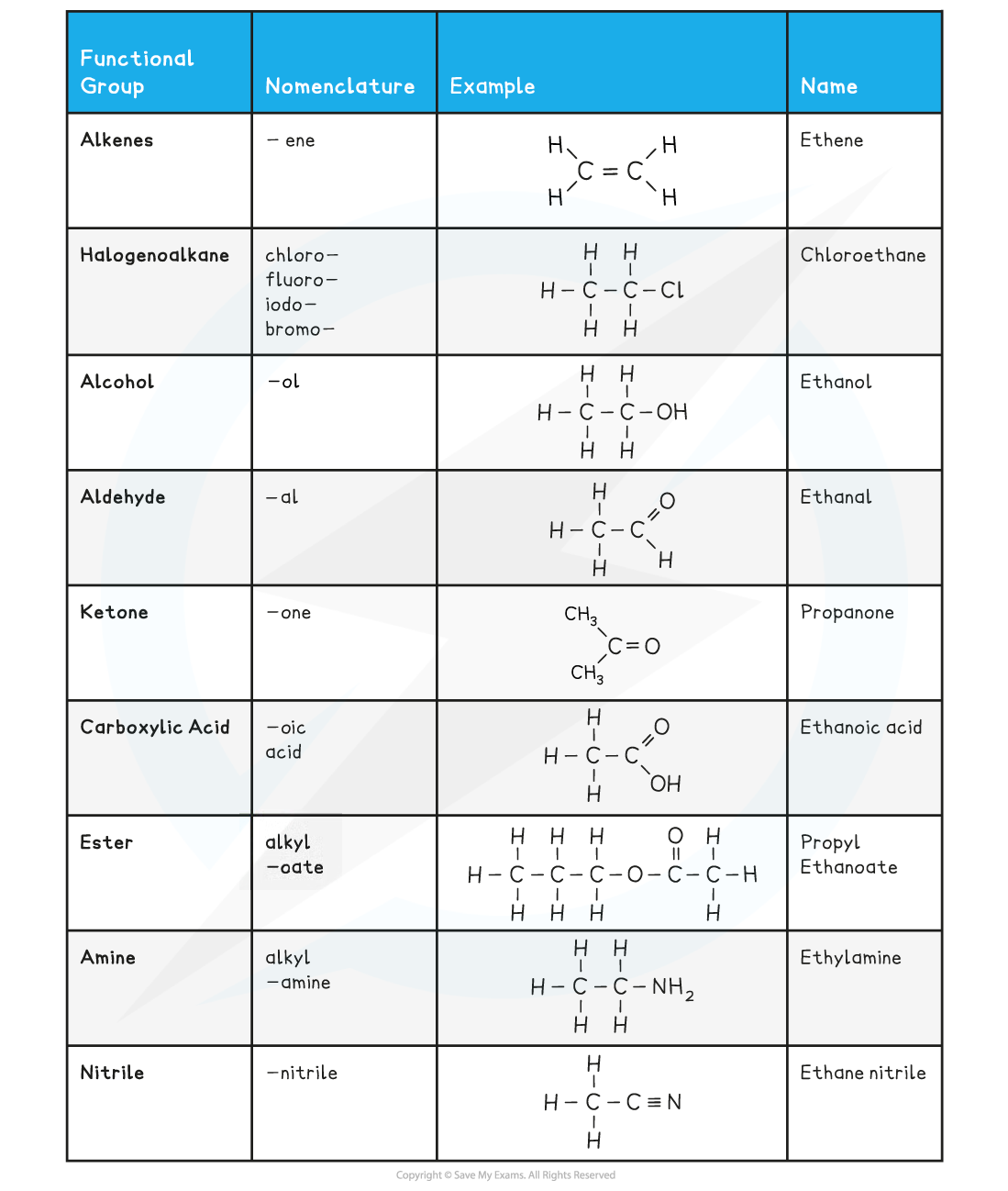Chemical Names & Formulae (OCR A Level Chemistry A): Revision Note
Exam code: H432
Systematic Nomenclature
Systematic nomenclature can be used to name organic compounds and therefore make it easier to refer to them
The alkanes provide the basis of the naming system and the stem of each name indicates how many carbon atoms are in the longest chain in one molecule of the compound
Nomenclature of Organic Compounds Table
Number of C atoms | Molecular formula of straight-chain alkane | Name of alkane | Stem used in naming |
|---|---|---|---|
1 | CH4 | methane | meth- |
2 | C2H6 | ethane | eth- |
3 | C3H8 | propane | prop- |
4 | C4H10 | butane | but- |
5 | C5H12 | pentane | pent- |
6 | C6H14 | hexane | hex- |
7 | C7H16 | heptane | hept- |
8 | C8H18 | octane | oct- |
9 | C9H20 | nonane | non- |
10 | C10H22 | decane | dec- |
If there are any side-chains or functional groups present, then the position of these groups is indicated by numbering the carbon atoms in the longest chain starting at the end that gives the lowest possible numbers in the name
The hydrocarbon side-chain is shown in brackets in the structural formula
CH3CH(CH3)CH2CH3
The side-chain is named by adding ‘-yl’ to the normal alkane stem
This type of group is called an alkyl group

Naming Side Chains
If there are more than one of the same alkyl side-chain or functional groups, di- (for two), tri- (for three) or tetra- (for four) is added in front of its name
The adjacent numbers have a comma between them
Numbers are separated from words by a hyphen

Naming Multiple Side Chains
If there is more than one type of alkyl side-chain, they are listed in alphabetic order

Naming Side Chains in Alphabetical Order
Examiner Tips and Tricks
An aliphatic compound is straight or branched-chain and also includes cyclic organic compounds that do not contain a benzene ring.
Functional Groups & their Nomenclature Table

Worked Example
Naming organic molecules
Name the following molecules using correct systematic nomenclature:

Answer 1:
2,5,5-trimethylhex-2-ene
The longest carbon chain is 6 carbons = hex
There is an alkene group which is a higher priority group than the methyl side chains
So, the carbons are numbered to make the alkene have the lowest possible number = -2-ene
This means that the methyl groups are on carbons 2, 5 and 5 = 2,5,5-trimethyl
Answer 2:
4-Methyleneheptane
The longest carbon chain is 7 carbons = hept
The bonds within the longest chain are all single bonds = ane
There is an alkene side chain on carbon 4 = 4-Methylene
Note: There is an argument for this to be called 2-propylpent-1-ene as the alkene group typically is a high priority, however, this is not the correct systematic nomenclature
Answer 3:
Propanal
The longest carbon chain is 3 carbons = prop
There is an aldehyde group = al
By convention, the aldehyde group is attached to carbon-1
The bonds within the main chain are all single bonds = an
Answer 4:
3-methylbutanal
The longest carbon chain is 4 carbons = but
There is an aldehyde group = al
By convention, the aldehyde group is attached to carbon-1
The bonds within the main chain are all single bonds = an
There is a methyl side chain attached to carbon-3 = 3-methyl
Answer 5:
Butanoic acid
The longest carbon chain is 4 carbons = but
There is a carboxylic acid group = -oic acid
By convention, the carboxylic acid is attached to carbon-1
The bonds within the main chain are all single bonds = an
Answer 6:
2-chlorobutane
The longest carbon chain is 4 carbons = but
The bonds within the main chain are all single bonds = an
There is a chlorine atom attached to carbon-2 = 2-chloro
Organic Formulae
The general formula is a formula that represents a homologous series of compounds using letters and numbers
E.g. the general formula of alkanes is CnH2n+2
A homologous series is a group of organic compounds that have the same functional group, the same general formula and the same chemical properties
The structural formula is a formula that shows how the atoms are bonded to each carbon atom in a molecule
The displayed formula is a 2D representation of an organic molecule showing all its atoms (by their symbols) and their bonds (by single, double or triple bonds)
The skeletal formula is a simplified displayed formula with all the carbon and hydrogen atoms removed, with the exception of hydrogens that are part of a functional groups, e.g. OH
Overview of the Formulae of Organic Compounds Table

Worked Example
Drawing skeletal formulae of molecules Draw the skeletal formula of the following molecules:
CH3(CH2)3OH
(CH3)2CHCH2OH
CH3CH2OCH2CH3
Answer:

Worked Example
Drawing displayed formulae of molecules Draw the displayed formula of the following molecules:

Answer


Unlock more, it's free!
Did this page help you?